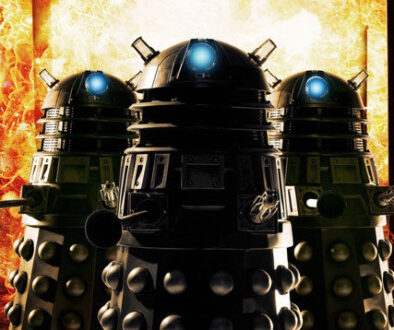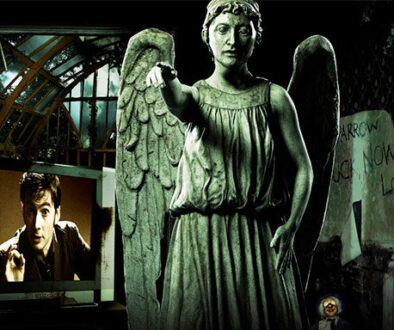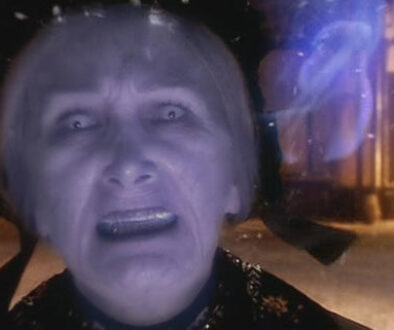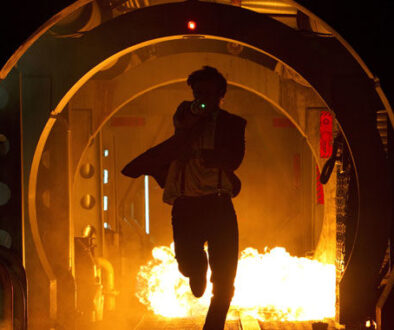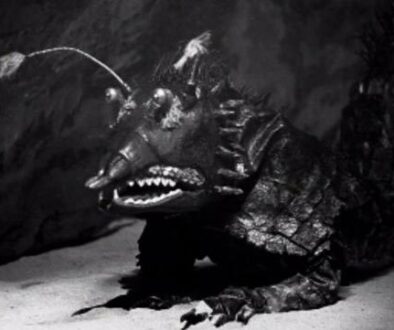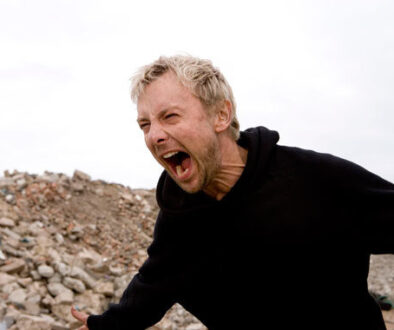The Case For… the McCoy Era

Guest contributor Ben Morton defends the final years of Doctor Who’s original run.
I thought I might as well give a shot expressing my views on the Seventh Doctor played by the wonderful Sylvester McCoy, even though bear in mind, I started watching Doctor Who with the Ninth Doctor, and latterly watched other Doctors, McCoy being one of the best.
In early 1987, Doctor Who was in jeopardy. Colin Baker (Doctor. No 6) technically got given his notice by John Nathan Turner (JNT), the ratings were getting lower, and without JNT’s motivation, the show would’ve been axed by Michael Grade, who hated Doctor Who. This was the same man who went on to destroy the regional companies of ITV a decade and a half later… Anyhow, JNT hired McCoy.
Sylvester had played a lot of comedy parts, and indeed was part of Ken Campbell’s Roadshow in the 70’s doing life-threatening stunts with a essence of humour (e.g. a toy train with a sharp fork stabbing a chained McCoy quite severely with over-dramatic music!) McCoy was also noted for his work on children’s programmes such as Vision On and Tiswas.
When McCoy got announced, there was a uproar that McCoy “was a unknown” and would play the character like a cartoon one. Unknown to others however, McCoy’s eccentric Scottish personality suited the programme down to a tee. There was always an element of comedy in the series, starting from Hartnell, going through Troughton, Pertwee, Baker, Davison, Baker; and can even be reflected in the new series.
The costume of McCoy’s Doctor was designed by Ken Trew and based on a 20’s/30’s golfing outfit- making the character seem similar to that of a PG Wodehouse one. Complete with cravat hat, and question mark umbrella, this established the early years of the seventh incarnation.
Season 24 started in 1987 with Time and The Rani. This was written by husband and wife team Pip and Jane Baker, who also wrote The Trial of a Time Lord (for season 23) with Colin Baker presumably in mind to play the role. However, it quickly got rewritten to include a regeneration sequence from Baker (In reality, McCoy in a wig!) to McCoy (minus a wig… ahem).
Time and The Rani marked the return of Kate O’ Mara as the female Master, otherwise known as the Rani, hence the title. In a nutshell, the story involved the Rani wanting to kill the Doctor, and Mel (Bonnie Langford) trapped in a killer bubble. Not the best way to start a new season, granted, but the introduction, wardrobe segments, referencing the second, third, fourth and fifth doctors; quirky quotes of McCoy’s Doctor (“You don’t understand regeneration, Mel. It’s a lottery, and I’ve drawn the short plank”) and the new take on the Doctor Who theme by Keff McCulloch saved the serial.
The second serial, Paradise Towers by Stephen Wyatt, is basically a sci-fi version of Fawlty Towers; Richard Briers plays the Chief Caretaker who looks very much like Blakey from On the Buses (“I hate you, Doctor!”). This episode, even though I’ve only seen clips, reminds me a bit of Gridlock (Season 29), where two ladies are gossiping to the Doctor in a comfy environment, complete with armchairs. And yes, this one involves Bonnie Langford screaming and being sucked into a swimming pool.
The only thing I know about serial three, Delta and The Bannerman, is the guest appearance of comedian Ken Dodd as the tollmaster. This is one of the rare episodes where another character looks more bonkers than the Doctor – it was 1987 after all!
The last serial of Season 24 called Dragonfire saw the overdue (in my opinion) departure of Mel. The reason I say this is because McCoy’s Doctor (except from his costume and occasional jokes) couldn’t develop and become officially a new incarnation because the debris from the destruction of Baker’s era still existed and was part of the running continuity.
Unlike Rose (Billie Piper) and the 9th/10th Doctors, we saw the bond between them, latterly causing Rose and the Doctor to fall in love (The Meta-crisis one, that is). However, Mel didn’t stay in the programme long enough to grow a friendship/connection with the 7th Doctor and to adapt to his character.
Sophie Aldred was introduced as Ace, a young girl from 1989 earth. This concept of the Doctor getting a young companion relative to real-life broadcast was recycled in 2005 with the event of the Doctor meeting Rose (2005); The Doctor meeting Donna, Martha, Amy Pond, etc.
Doctor Who was Sophie’s first ever acting job and she brought a freshness to the programme, calling the Doctor “Professor” for some strange reason (“I’m not ‘the Professor’, I’m the Doctor!”), often carrying a very 80’s boombox or Nitro-9 : a few lines from Silver Nemesis sums it up:
The Doctor: I don’t suppose you’ve completely ignored my instructions and secretly prepared any Nitro-9, have you?
Ace: What if I had?
The Doctor: And naturally, you wouldn’t do anything so insanely dangerous as to carry it around with you, would you?
Ace: Of course not. I’m a good girl and do what I’m told.
The Doctor: Excellent. Blow up that vehicle.
However, this didn’t stop viewing figures dropping quickly. Surprisingly, this was one of the rare seasons to feature only ONE of the recurring villains/monsters.
For season 25, and the 25th anniversary celebrations, the Daleks and Davros were brought back to face the madcap Seventh Doctor. In the first serial (Remembrance of The Daleks), past episodes were mentioned by the Doctor as events that happened to earth. The Doctor’s attitude towards the Daleks and Davros changed, shaping the outlook The Eleventh Doctor has on them as of current. He expressed his annoyance of the Daleks wasting their time trying to conquer earth as usual, and indeed, wanted to get rid of them. They did so in his eighth/ninth incarnation with the destruction of Skaro, or so he thought.
The Happiness Patrol featured one of the strangest monsters to be created ever – The Kandy Man. The Kandy Man was like a walking, talking evil version of Bertie Bassett. Bassett’s lawsuit against the BBC soon afterwards meant The Kandy Man; yet looking “sweet” and cute could never be used again. Well, we won’t see him anytime soon in the 50th celebrations. This episode was supposed to be “anti-Thatcher”- erm, how? Sylvester McCoy telling jokes on stage in the style of Ben Elton, and laughing out loud maybe?
Silver Nemesis saw the return of the Cybermen, and had several explosions/action scenes which set the scene for the revived series.
The one serial however that showed McCoy’s comedy roots was The Greatest Show in the Galaxy, the last episode of Season 25. This included McCoy playing the spoons (which was the second time a incarnation of the Doctor played a musical instrument, and which McCoy did prior to being in Doctor Who); entertaining stone gods with some magic tricks “You ain’t seen nothing yet!”, and Ace getting freaked out by clowns (Some people do find them scary!)
McCoy risked life and limb for this serial; towards the end, one famous scene has McCoy walking slowly away from a circus tent, whilst a huge explosion took place right behind him. In reality, this could only be recorded/done once, due to the budget. McCoy walked on, and very narrowly missed certain death, and had no idea if he had any skin or even clothes left after the take.
Of course, explosions are featured in the revived series of Doctor Who, but most of it’s done by green screen.Back in 1989, green screen wasn’t as advanced as it is now and health and safety regulations in relation to stunts were a lot less looser; McCoy technically established the “no fear” Doctor which was never really repeated with Doctors to come – now that’s devotion to your job.
Season 26 reintroduced the Doctor’s old companion and friend Brigadier Lethbridge-Stewart as a retired old man in Battlefield. The chemistry between McCoy’s Doctor and The Brig is wonderful, as it’s similar to how the other incarnations have been around him. Indeed, references are made to Jon Pertwee’s era of Doctor Who; with the mention of Doris.
McCoy literally became a life-saver in this serial, forgetting about the portrayal of The Doctor, by saving Sophie Aldred from drowning. She almost drowned when a scene was being filmed which involved a dodgy water tank and electrical wires. Sylvester noticed the glass cracking and shouted to get her out. After this near-death experience, the cast and crew left the studio quickly to avoid being drowned/electrocuted. Without McCoy noticing, several members of the cast and crew including maybe McCoy and Aldred would’ve been killed.
The next serial was Ghost Light, which had McCoy’s Doctor in a darker jacket. From this serial onwards, The Doctor was played as a more-serious role with a few humourous bits still included; and the TARDIS started to become a background object; only used when travelling to one place to another, and not used much as a setting.
The Curse of Fenric references The Curse of Peladon. This featured presenter Nicholas Parsons as Reverend Wainwright. I’ve never seen this episode, but I’ve seen brief clips. Very dramatic according to the clips I’ve seen.
Survival was the last ever serial of the original Doctor Who, and was basically based on earth, with the return of the classic Anthony Ainley as The Master turning into…a cat! It doesn’t make any sense, in my eyes, how another Time Lord could regenerate into a feline creature, and then randomly send the Doctor to a sinister location for his destruction; where have I seen that before? (Cough, cough – Last of the Time Lords).
Ace thinks The Doctor’s dead; that concept was reused several times again (notable examples: The Parting of the Ways, where the Ninth Doctor declares to Rose through a TARDIS hologram that he’s going to die- and eventually he does into the tenth; and the most recent example of a similar plot lasted throughout the whole of Series 6 that the Eleventh Doctor is “killed” by an astronaut near a lake.)
The following narration by McCoy was dubbed at the end of Survival: “There are worlds out there where the sky is burning, where the sea’s asleep and the rivers dream, people made of smoke and cities made of song. Somewhere there’s danger, somewhere there’s injustice and somewhere else the tea is getting cold. Come on, Ace, we’ve got work to do.”
Michael Grade finally got what he wanted, the programme to end after 26 years and paving the way to a new BBC image in the 1990’s. It came as a big shock to John Nathan Turner, the producer of Doctor Who for almost a decade.
This meant that even though the TV series came to a sudden end, it could carry on in the form of novels called New Adventures. Some of the novels written were going to be serials for the proposed Season 27 in 1990- the novels made it so that Doctor Who was no longer constrained by budget, because the reader’s imagination could dream up the scene.
If Season 27 did happen, McCoy confessed that he would’ve got rid of the “awful question mark polo jumper”, and Sophie would’ve left the programme to live on Gallifrey much like Romana II and K-9 did in 1980.
McCoy returned as the Doctor twice again visually: once in a children’s school programme called “Search Out Space” which had no plot and a lot of silly gibberish. Sophie Aldred also returned as Ace, and surprisingly, John Leeson returned as an unspecified K-9. JNT was not involved at all, so that’s probably why!
There was a non-canonical appearance by Doctors 3-7 in Dimensions in Time (1993), a poorly-written script by John Nathan Turner to celebrate 30 years of the series AND Children In Need. The plot made no sense, as it was done bit by bit, and the Doctors never met one another. It was very badly mistreated and effects were more considered as it was screened in 3D.
McCoy decided to hand over the TARDIS keys in 1996 to Paul McGann. McCoy’s Doctor (although only seen for about the first 10 minutes) had a complete change, compared to the clown about a decade before.
The TARDIS got changed from having a low-budget BBC wobbly control room to a magnificent hall. The way the seventh Doctor died was quite frankly the most shocking death ever for a Doctor. Yes, it would’ve been nice to see McCoy play the role for the whole tele-film, but the love scene between Grace and the Eighth Doctor would not have existed.
If McCoy didn’t leave, then the show could’ve taken a different road compared to the one that happened. Sure, the plots would change slightly, but The Doctor could still wear a fez (he did actually in another episode: it’s on YouTube somewhere!)
After Doctor Who, McCoy became well known for his other acting work in Doctors and his upcoming role in The Hobbit. Sophie Aldred became a established children’s TV presenter, with such shows as Melvin and Maureen’s Music-a-Grams, Words and Pictures, Zzzap! (one of my favourite kids shows) and most recently, Tree Fu Tom. The two still do Doctor Who audio plays by Big Finish Adventures which ensures their adventures carry on.
In my opinion, McCoy was, and in a sense, still is the Doctor who shaped the character as we know him nowadays, a mix of humour and seriousness. Not highly regarded as the best Doctor ever; some say he was responsible for the unannounced end of the original series, some say he played the part like a children’s programme character; whilst others regard him as a serious character when he had to be.
McCoy is still as of current eager to play the Doctor for the 50th anniversary, and indeed, a lot of McCoy elements are used for the Eleventh Doctor: being quirky and eccentric. One thing that McCoy managed to maintain, despite the bad storylines and negative response, was the mystery of the Doctor’s character.
At least, that’s one thing that remained and always will do- this strange rubber-faced man travelling around time and space in a blue box with a question mark umbrella, tipping his hat everywhere he goes.



